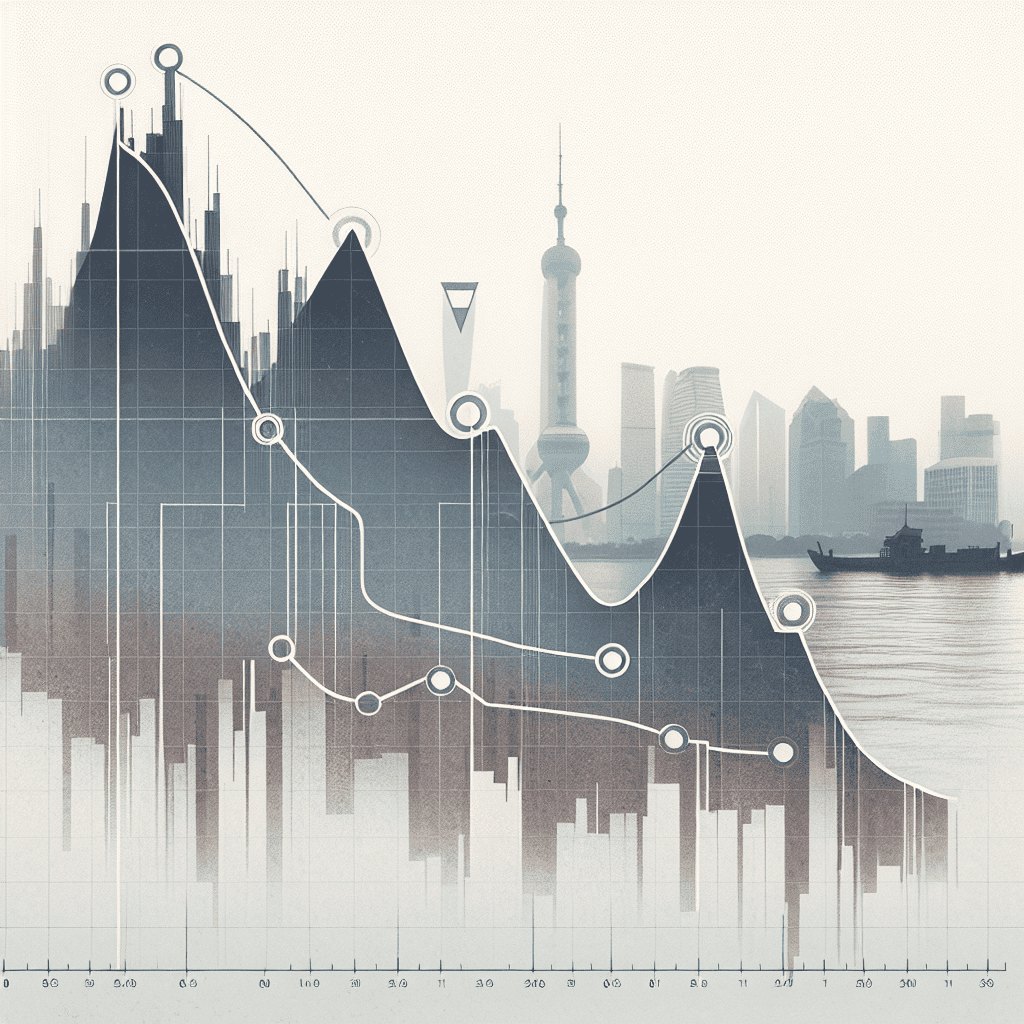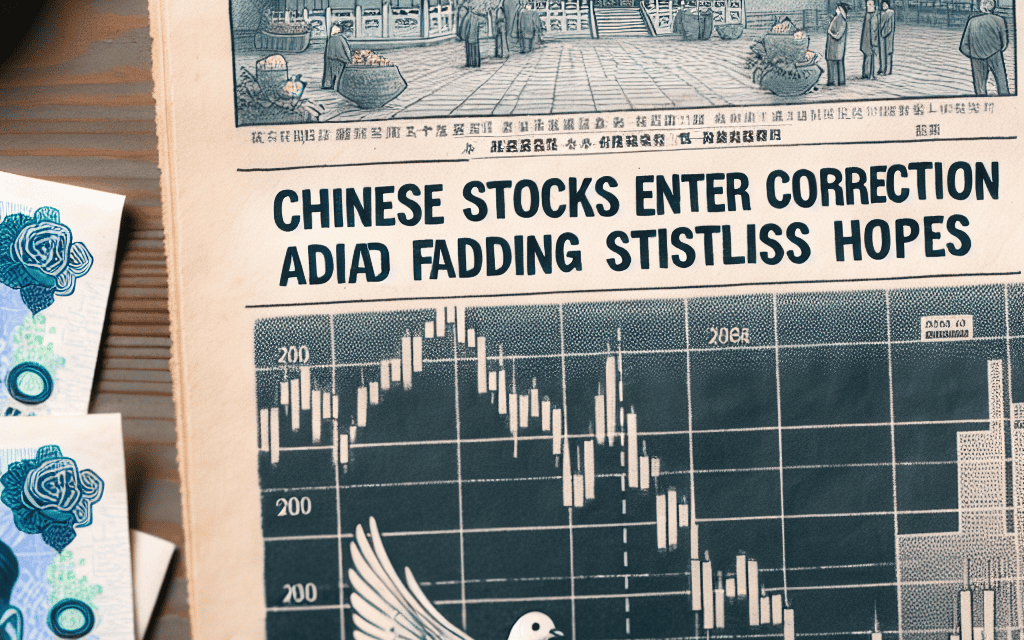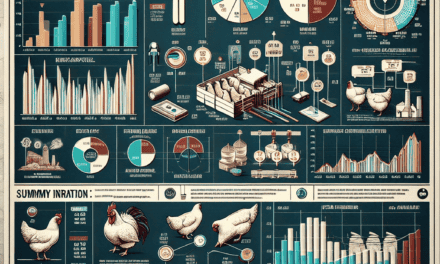“Chinese Stocks Tumble: Stimulus Hopes Dim, Market Correction Looms”
Introduction
Chinese stocks have recently entered a correction phase, reflecting growing investor concerns as hopes for substantial economic stimulus measures wane. This downturn comes amid a backdrop of global economic uncertainty and domestic challenges, including regulatory pressures and a slowing economy. The initial optimism surrounding potential government interventions to bolster growth has diminished, leading to a reassessment of market valuations and future prospects. As a result, investors are recalibrating their strategies, contributing to increased volatility and a cautious outlook for the Chinese stock market.
Impact Of Fading Stimulus Hopes On Chinese Stock Market
The recent downturn in Chinese stocks has captured the attention of global investors, as the market enters a correction phase amid diminishing hopes for substantial economic stimulus from the Chinese government. This development has significant implications for both domestic and international stakeholders, as it reflects broader concerns about the health of the world’s second-largest economy. The correction, defined as a decline of 10% or more from a recent peak, underscores the volatility and uncertainty that have characterized Chinese markets in recent months.
Initially, optimism surrounding potential government intervention had buoyed investor sentiment, with many anticipating that Beijing would implement robust measures to stimulate growth. However, as these expectations have waned, so too has the confidence of investors. The Chinese government’s cautious approach to stimulus, focusing on targeted measures rather than sweeping reforms, has led to a reassessment of growth prospects. This shift in perception has been exacerbated by a series of economic indicators suggesting a slowdown, including weaker-than-expected industrial output and retail sales figures.
Moreover, the property sector, a critical component of China’s economy, has been a focal point of concern. The ongoing struggles of major real estate developers, coupled with regulatory crackdowns, have heightened fears of a broader economic slowdown. As property sales and prices continue to decline, the ripple effects are being felt across various sectors, further dampening investor sentiment. Consequently, the lack of decisive government action to address these issues has contributed to the market’s downward trajectory.
In addition to domestic factors, external pressures have also played a role in the correction of Chinese stocks. The global economic environment remains challenging, with rising interest rates and geopolitical tensions adding to the uncertainty. The U.S.-China trade relationship, in particular, continues to be a source of volatility, as both nations navigate a complex web of tariffs and negotiations. These external dynamics have compounded the challenges facing Chinese markets, as investors weigh the potential impact on trade and economic growth.
Furthermore, the correction in Chinese stocks has implications for global markets, given China’s integral role in the world economy. As Chinese equities decline, there is a risk of contagion, with potential spillover effects on other emerging markets and global supply chains. Investors worldwide are closely monitoring the situation, as any significant disruptions in China could have far-reaching consequences for international trade and investment flows.
Despite the current challenges, some analysts remain cautiously optimistic about the long-term prospects for Chinese stocks. They argue that the correction may present buying opportunities for investors with a higher risk tolerance, particularly in sectors poised for growth, such as technology and renewable energy. Additionally, there is hope that the Chinese government may yet unveil more comprehensive stimulus measures if economic conditions continue to deteriorate.
In conclusion, the correction in Chinese stocks amid fading stimulus hopes highlights the complex interplay of domestic and international factors influencing the market. While the immediate outlook remains uncertain, the situation underscores the importance of closely monitoring economic indicators and policy developments. As investors navigate this challenging landscape, the need for a nuanced understanding of the risks and opportunities in Chinese markets has never been more critical.
Key Factors Driving The Correction In Chinese Stocks
Chinese stocks have recently entered a correction phase, a development that has captured the attention of global investors and analysts alike. This downturn is primarily driven by diminishing hopes for substantial economic stimulus from the Chinese government, a factor that has historically played a significant role in buoying market sentiment. As investors recalibrate their expectations, several key factors are contributing to the current correction in Chinese equities.
To begin with, the Chinese government’s cautious approach to economic stimulus has been a pivotal factor in shaping market dynamics. In recent months, there has been growing anticipation that Beijing would introduce robust fiscal and monetary measures to counteract the slowing economic growth. However, the government’s reluctance to deploy large-scale stimulus packages has led to a reassessment of growth prospects among investors. This tempered approach is partly due to concerns about rising debt levels and the potential long-term implications of aggressive stimulus measures. Consequently, the absence of decisive policy action has dampened investor confidence, leading to a sell-off in Chinese stocks.
Moreover, the ongoing challenges within China’s real estate sector have further exacerbated the situation. The property market, a critical component of the Chinese economy, has been grappling with a series of issues, including high levels of corporate debt and regulatory crackdowns on speculative activities. These challenges have not only weighed on property developers but have also had a ripple effect across related industries, thereby impacting the broader market sentiment. As a result, investors are increasingly wary of the potential for further disruptions in the real estate sector, which has contributed to the downward pressure on stock prices.
In addition to domestic factors, external influences have also played a role in the correction of Chinese stocks. The global economic environment remains fraught with uncertainty, with concerns about inflation, interest rate hikes, and geopolitical tensions creating a challenging backdrop for investors. In particular, the tightening monetary policies of major central banks, such as the U.S. Federal Reserve, have led to capital outflows from emerging markets, including China. This shift in global capital flows has added to the volatility in Chinese equity markets, as investors seek safer havens amid the prevailing uncertainty.
Furthermore, the regulatory landscape in China continues to be a source of concern for investors. Over the past year, the Chinese government has implemented a series of regulatory reforms aimed at addressing issues such as data privacy, antitrust practices, and financial stability. While these measures are intended to create a more sustainable economic environment in the long term, they have introduced a degree of unpredictability in the short term. The regulatory crackdown on technology companies, in particular, has led to significant market volatility, as investors grapple with the implications of these policy changes.
In conclusion, the correction in Chinese stocks is the result of a confluence of factors, both domestic and international. The fading hopes for substantial economic stimulus, coupled with challenges in the real estate sector and a complex regulatory environment, have created a challenging landscape for investors. As the global economic environment remains uncertain, the outlook for Chinese equities will likely depend on the government’s ability to navigate these challenges while maintaining a balance between growth and stability. Investors will be closely monitoring developments in policy and market conditions, as they seek to understand the evolving dynamics of the Chinese economy and its implications for global markets.
Investor Sentiment And Its Role In Chinese Stock Volatility
Investor sentiment plays a crucial role in the volatility of Chinese stocks, particularly as these markets recently entered a correction phase amid diminishing hopes for government stimulus. The Chinese stock market, known for its rapid fluctuations, often reflects the broader economic and political landscape of the country. As investors navigate these turbulent waters, their perceptions and expectations significantly influence market movements, creating a feedback loop that can either stabilize or destabilize stock prices.
In recent months, the anticipation of government intervention to bolster the economy has been a key driver of investor sentiment. Historically, the Chinese government has been known to implement stimulus measures to support economic growth, especially during periods of slowdown. Such interventions have included monetary easing, fiscal spending, and regulatory adjustments aimed at boosting consumer confidence and encouraging investment. However, as hopes for substantial stimulus measures have waned, investor sentiment has shifted, leading to increased volatility in the stock market.
The fading optimism regarding government intervention can be attributed to several factors. Firstly, China’s economic recovery from the pandemic has been uneven, with certain sectors rebounding more quickly than others. This uneven recovery has led to uncertainty about the necessity and timing of potential stimulus measures. Additionally, the Chinese government has shown a growing focus on long-term economic stability and structural reforms, rather than short-term stimulus. This shift in policy priorities has tempered expectations for immediate intervention, further influencing investor sentiment.
Moreover, global economic conditions have also played a role in shaping investor perceptions. The ongoing trade tensions between China and other major economies, particularly the United States, have added an additional layer of complexity to the economic outlook. These tensions have heightened concerns about the potential impact on China’s export-driven economy, thereby affecting investor confidence. Furthermore, the global economic slowdown, exacerbated by geopolitical uncertainties and supply chain disruptions, has contributed to a more cautious approach among investors.
As a result of these factors, Chinese stocks have experienced increased volatility, with many investors adopting a wait-and-see approach. This cautious sentiment is reflected in the recent correction phase, where stock prices have declined as investors reassess their positions in light of the changing economic landscape. The correction has been characterized by a broad-based sell-off, affecting various sectors and leading to a reevaluation of risk and return expectations.
Despite the current volatility, it is important to recognize that investor sentiment is inherently dynamic and can change rapidly in response to new information or developments. While the current sentiment may be cautious, any signs of positive economic data or policy shifts could quickly alter the market’s trajectory. For instance, if the Chinese government were to announce targeted measures to support key industries or stimulate domestic consumption, it could reignite investor optimism and lead to a rebound in stock prices.
In conclusion, investor sentiment is a key determinant of Chinese stock volatility, particularly in the context of fading stimulus hopes. As investors grapple with uncertainty surrounding government intervention and global economic conditions, their perceptions and expectations continue to drive market movements. Understanding the interplay between sentiment and market dynamics is essential for navigating the complexities of the Chinese stock market, as it remains a barometer of broader economic trends and policy shifts.
Sector Analysis: Which Chinese Industries Are Most Affected?

Chinese stocks have recently entered a correction phase, a development that has sent ripples through various sectors of the economy. This downturn is largely attributed to diminishing hopes for substantial government stimulus, which many investors had anticipated would bolster economic growth. As the reality of limited intervention sets in, different industries are experiencing varying degrees of impact, with some sectors more vulnerable than others.
The technology sector, a cornerstone of China’s economic ambitions, has been particularly affected. Companies in this industry have faced a dual challenge: regulatory scrutiny and now, the lack of expected fiscal support. The Chinese government’s regulatory crackdowns over the past few years have already created an environment of uncertainty, and the absence of significant stimulus measures has further dampened investor confidence. As a result, tech stocks have seen notable declines, reflecting broader concerns about growth prospects in an increasingly competitive global market.
In contrast, the real estate sector, which has long been a pillar of China’s economic expansion, is grappling with its own set of challenges. The sector has been under pressure due to the government’s efforts to curb excessive borrowing and speculative investments. The anticipated stimulus was expected to provide some relief, potentially easing liquidity constraints and stabilizing property prices. However, with these hopes fading, real estate companies are facing heightened financial strain, leading to a correction in stock prices. This situation is exacerbated by the ongoing debt issues faced by major property developers, which continue to cast a shadow over the sector’s recovery.
Meanwhile, the manufacturing industry, a critical component of China’s export-driven economy, is also feeling the effects of the stock market correction. The sector has been navigating a complex landscape marked by global supply chain disruptions and fluctuating demand. The lack of significant stimulus measures has added to these challenges, as manufacturers had hoped for policies that would enhance domestic consumption and support industrial growth. Consequently, the manufacturing sector is experiencing a slowdown, with stock prices reflecting concerns about future profitability and competitiveness.
On the other hand, the consumer goods sector presents a more nuanced picture. While some segments, such as luxury goods, have shown resilience due to sustained demand from affluent consumers, other areas are not as fortunate. The broader consumer market is sensitive to economic fluctuations, and the absence of robust stimulus measures has led to cautious spending behavior among the general population. This has resulted in a mixed performance within the sector, with companies catering to everyday consumer needs facing more significant challenges.
In addition to these industry-specific impacts, the overall sentiment in the Chinese stock market is one of caution. Investors are recalibrating their expectations in light of the government’s restrained approach to economic intervention. This shift in sentiment is influencing capital flows, with some investors opting to diversify their portfolios by seeking opportunities in other markets or asset classes.
In conclusion, the correction in Chinese stocks amid fading stimulus hopes is having a varied impact across different sectors. While technology and real estate are among the most affected, manufacturing and consumer goods are also experiencing challenges. As the market adjusts to this new reality, the focus will likely shift towards identifying sectors that can adapt and thrive in an environment characterized by limited government support and evolving economic conditions.
Historical Context: Comparing Past Corrections In Chinese Stocks
The recent correction in Chinese stocks, marked by a significant decline in market indices, has drawn attention to the historical patterns of market corrections in China. To understand the current situation, it is essential to compare it with past corrections, examining the underlying causes and the broader economic context. Historically, Chinese stock markets have experienced several corrections, each influenced by a unique set of factors, yet often sharing common themes such as government policy shifts, economic reforms, and global economic conditions.
One notable correction occurred in 2015, when the Shanghai Composite Index plummeted by nearly 30% in a matter of weeks. This dramatic downturn was primarily driven by a combination of speculative trading and regulatory changes. At the time, the Chinese government had encouraged retail investors to participate in the stock market, leading to a rapid increase in stock prices. However, when the government introduced measures to curb excessive speculation, the market reacted sharply, resulting in a significant correction. This episode highlighted the impact of regulatory interventions and the volatility that can arise from rapid market expansions.
In contrast, the correction in 2008 was largely influenced by global economic conditions. The global financial crisis had a profound impact on economies worldwide, and China was no exception. Although the Chinese economy was relatively insulated due to its strong domestic market and government controls, the ripple effects of the crisis led to a decline in exports and a slowdown in economic growth. Consequently, Chinese stocks experienced a correction as investor confidence waned amid global uncertainty. This period underscored the interconnectedness of global markets and the susceptibility of Chinese stocks to external economic shocks.
The current correction, characterized by fading hopes for government stimulus, shares similarities with past corrections but also presents unique challenges. In recent months, investors had anticipated significant government intervention to bolster the economy, particularly in response to slowing growth and ongoing trade tensions. However, as these expectations have diminished, investor sentiment has shifted, leading to a decline in stock prices. This situation is reminiscent of past corrections where government policy played a pivotal role in shaping market dynamics.
Moreover, the current correction is occurring in a context of heightened global economic uncertainty. Trade tensions between China and major economies, particularly the United States, have created an environment of unpredictability. Additionally, concerns about the global economic slowdown and its potential impact on China’s export-driven economy have further contributed to the market’s decline. These factors highlight the complex interplay between domestic policies and global economic conditions in influencing Chinese stock markets.
In comparing past corrections with the current situation, it becomes evident that while the specific triggers may differ, the underlying themes of government policy, economic conditions, and investor sentiment remain consistent. Understanding these historical patterns provides valuable insights into the dynamics of Chinese stock markets and the factors that drive corrections. As investors navigate the current correction, they can draw lessons from the past, recognizing the importance of policy signals and global economic trends in shaping market outcomes. Ultimately, the ability to adapt to changing conditions and anticipate potential shifts will be crucial for investors seeking to navigate the complexities of Chinese stock markets.
Strategies For Investors During A Chinese Stock Market Correction
As Chinese stocks enter a correction phase, driven by diminishing hopes for substantial economic stimulus, investors are faced with the challenge of navigating a volatile market environment. This period of correction, characterized by a decline of at least 10% from recent highs, can be unsettling. However, it also presents opportunities for strategic investment decisions. Understanding the underlying factors contributing to the current market dynamics is crucial for investors seeking to make informed choices.
The initial optimism surrounding potential government intervention to bolster the Chinese economy has waned, leading to a reassessment of market valuations. Investors had anticipated significant fiscal and monetary measures to counteract slowing growth, but the reality has been more tempered. This shift in expectations has prompted a reevaluation of asset allocations, as market participants adjust to a landscape where immediate, large-scale stimulus appears unlikely. Consequently, investors must adopt strategies that account for both the risks and opportunities inherent in this environment.
One approach is to focus on diversification, which remains a fundamental principle in managing market volatility. By spreading investments across various sectors and asset classes, investors can mitigate the impact of a downturn in any single area. In the context of Chinese stocks, this might involve balancing exposure between domestic companies and those with significant international operations. Companies with a global footprint may be better positioned to weather domestic economic challenges, providing a buffer against localized market corrections.
Moreover, investors should consider the long-term growth prospects of the Chinese economy, which, despite current challenges, remains one of the world’s largest and most dynamic. Structural reforms, technological advancements, and a burgeoning middle class continue to offer compelling investment opportunities. Therefore, maintaining a long-term perspective can help investors avoid the pitfalls of short-term market fluctuations. By focusing on companies with strong fundamentals and sustainable growth trajectories, investors can position themselves to benefit from future economic recovery.
In addition to diversification and a long-term outlook, investors might explore defensive sectors that tend to be more resilient during economic downturns. Industries such as healthcare, consumer staples, and utilities often exhibit stability in times of market stress, as they provide essential goods and services that remain in demand regardless of economic conditions. Allocating a portion of a portfolio to these sectors can help cushion against broader market declines.
Furthermore, it is essential for investors to stay informed about policy developments and economic indicators that could influence market sentiment. Regularly reviewing economic data releases, government announcements, and geopolitical events can provide valuable insights into potential market movements. This proactive approach enables investors to adjust their strategies in response to changing conditions, thereby enhancing their ability to navigate a correction effectively.
Finally, maintaining a disciplined approach to risk management is paramount. Setting clear investment goals, establishing stop-loss orders, and adhering to predetermined asset allocation strategies can help investors manage their exposure to market volatility. By implementing these measures, investors can protect their portfolios from excessive losses while remaining positioned to capitalize on opportunities as they arise.
In conclusion, while the current correction in Chinese stocks presents challenges, it also offers a chance for investors to refine their strategies and strengthen their portfolios. By embracing diversification, focusing on long-term growth, exploring defensive sectors, staying informed, and practicing disciplined risk management, investors can navigate this period of uncertainty with greater confidence and resilience.
Global Implications Of The Chinese Stock Market Correction
The recent correction in Chinese stocks has sent ripples across global financial markets, raising concerns about the broader implications for the world economy. As investors grapple with the fading hopes of substantial economic stimulus from Beijing, the downturn in Chinese equities underscores the interconnectedness of global markets and the potential for widespread economic repercussions. This correction, characterized by a significant decline in stock prices, reflects a growing apprehension about China’s economic trajectory and its ability to sustain growth without the anticipated government intervention.
To understand the global implications, it is essential to consider China’s pivotal role in the world economy. As the second-largest economy, China is a major driver of global growth, and its financial health is closely monitored by investors worldwide. The correction in Chinese stocks, therefore, is not merely a domestic issue but a signal that reverberates through international markets. Investors, wary of the potential slowdown in China’s economic engine, may adjust their portfolios, leading to volatility in other markets. This shift in investor sentiment can result in capital outflows from emerging markets, increased risk aversion, and a reevaluation of global growth prospects.
Moreover, the correction in Chinese stocks highlights the challenges faced by Beijing in balancing economic growth with financial stability. The Chinese government has been cautious in deploying large-scale stimulus measures, mindful of the risks associated with rising debt levels and asset bubbles. This prudent approach, while aimed at ensuring long-term stability, has led to short-term market disappointment. The absence of aggressive stimulus measures has dampened investor expectations, contributing to the stock market correction. Consequently, this cautious stance may influence other economies, particularly those heavily reliant on Chinese demand, to reassess their growth strategies and economic policies.
In addition to affecting investor sentiment, the correction in Chinese stocks has implications for global supply chains. China is a critical hub in the global supply chain network, and any slowdown in its economy can disrupt the flow of goods and services worldwide. Companies reliant on Chinese manufacturing and exports may face challenges, leading to potential delays and increased costs. This disruption can have a cascading effect, impacting production schedules, inventory management, and ultimately, consumer prices. As businesses navigate these challenges, the correction in Chinese stocks serves as a reminder of the vulnerabilities inherent in global supply chains.
Furthermore, the correction has geopolitical implications, as it may influence China’s economic diplomacy and its Belt and Road Initiative. A weaker stock market could constrain Beijing’s ability to finance large-scale infrastructure projects abroad, potentially altering the dynamics of international trade and investment. Countries that have benefited from Chinese investments may need to seek alternative sources of funding, reshaping regional economic alliances and partnerships.
In conclusion, the correction in Chinese stocks amid fading stimulus hopes is a multifaceted issue with far-reaching global implications. It underscores the interconnectedness of financial markets, the challenges of maintaining economic stability, and the vulnerabilities of global supply chains. As the world watches China’s next moves, the correction serves as a critical reminder of the delicate balance between growth and stability in an increasingly interconnected global economy. Investors, policymakers, and businesses alike must remain vigilant, adapting to the evolving landscape and preparing for the potential ripple effects of China’s economic trajectory.
Q&A
1. **What triggered the correction in Chinese stocks?**
The correction in Chinese stocks was triggered by fading hopes for significant economic stimulus from the Chinese government.
2. **Which sectors were most affected by the correction?**
Technology and real estate sectors were among the most affected by the correction in Chinese stocks.
3. **How did the Chinese government respond to the stock market correction?**
The Chinese government has been cautious in implementing large-scale stimulus measures, focusing instead on targeted support for specific sectors.
4. **What are the broader economic concerns impacting Chinese stocks?**
Broader economic concerns include slowing economic growth, regulatory crackdowns, and ongoing geopolitical tensions.
5. **How have international investors reacted to the correction in Chinese stocks?**
International investors have shown increased caution, with some reducing their exposure to Chinese markets amid uncertainty.
6. **What impact has the correction had on the Chinese economy?**
The correction has added to existing economic pressures, potentially affecting consumer and business confidence.
7. **Are there any signs of recovery in the Chinese stock market?**
While there have been some short-term rebounds, sustained recovery remains uncertain without clearer policy direction and economic stabilization.
Conclusion
Chinese stocks have entered a correction phase as investor optimism regarding potential government stimulus measures has waned. Initially buoyed by expectations of economic support to counteract slowing growth, the market’s sentiment has shifted due to a lack of concrete policy announcements or actions. This has led to increased volatility and a pullback in stock prices, reflecting broader concerns about China’s economic trajectory and the effectiveness of its policy responses. The correction underscores the market’s sensitivity to policy signals and the critical role of government intervention in sustaining investor confidence in China’s economic prospects.





